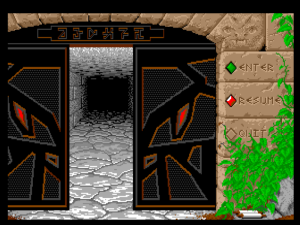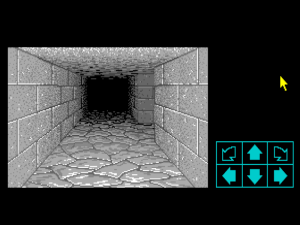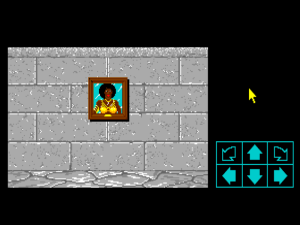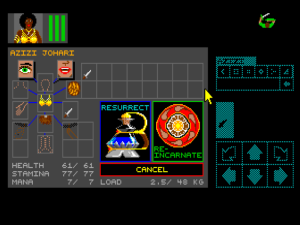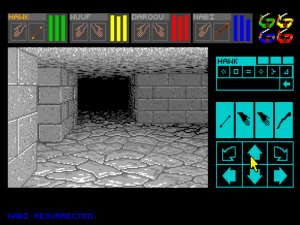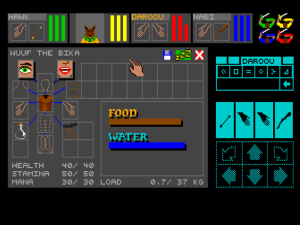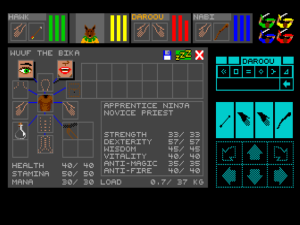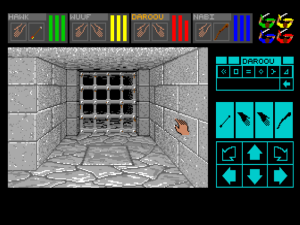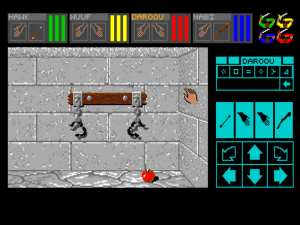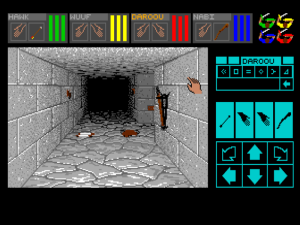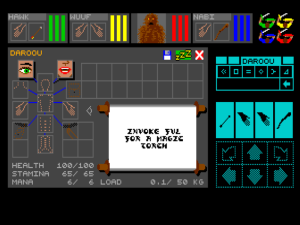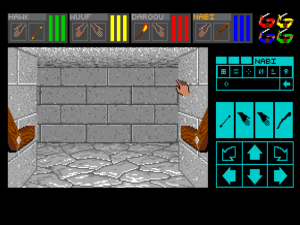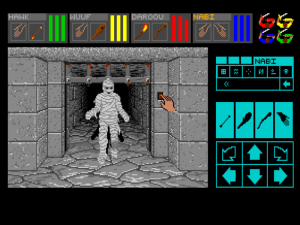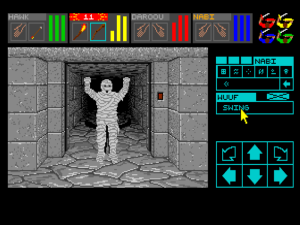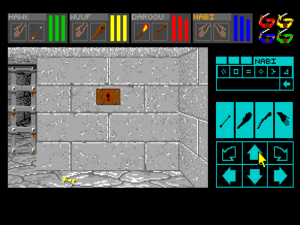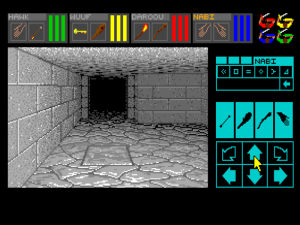Like any cagey revolutionary, Dungeon Master doesn’t lay all its cards on the table when we first meet it. When the curtain goes up — or, rather, when the iron gate opens — on its first level, we might think we’re just in for a Wizardry with better graphics and the luxury of a mouse-driven interface. Because this first level is entirely deserted, it’s not immediately obvious that the game is even running in real time, much less what a huge difference that quality is ultimately going to make to the experience. And because we can’t do anything at this point other than move around, it’s also not immediately obvious just what an interactive sort of dungeon we’ve just entered.
Still, there are already oddities, not least of which is the fact that we’ve been dropped into the game proper so very abruptly, without going through any of the usual rigmarole of rolling up characters or answering an old gypsy’s questions. Dungeon Master‘s fictional conceit has it that we are a sort of wandering spirit, whose first task must be to take charge of — possess? — up to 4 of the 24 characters found frozen in amber here in the first level’s so-called “Hall of Champions.” The characters in the Hall, supposedly adventurers who earlier tried to penetrate the dungeon and were rewarded with death for their efforts, provide a rare opportunity for FTL to let their hair down and toss a little pop culture into an otherwise almost aggressively austere game. In naming and drawing the characters we can choose from, FTL drew them from fictions like Dune, The Lord of the Rings, and their own previous game Sundog. They also included real-world figures like the Viking explorer Leif Eriksson and, because they were mostly young men with young men’s interests, 1975 Playboy Playmate Azizi Johari. Andy Jaros went fairly crazy with these portraits, making a whole “construction kit” for different combinations of bodies, facial features, and clothing. “Every female character,” remembers tools programmer Mike Newton wryly, “had a number of brassieres she could wear.”
The team was tempted to include Jaros’s construction kit along with a much more traditional character-creation process in the game itself. Wayne Holder remembers a “big schism” in his team between people “who just wanted to pick a character and get going” and those who wanted to laboriously roll their own, customizing every detail to their liking as in the CRPGs of yore. But, more than just being an inconvenience to new or impatient players, a character-creation process that took place outside of the dungeon would have worked against the sense of “you are there” immersion that was always the guiding philosophy of the game as a whole. Thus this casting of us as a wandering spirit in a Hall of Champions, an embodied part of the game’s world from the very first instant.
As a sop to those players that demanded more control, FTL made it possible to either “resurrect” or “reincarnate” each character. The former preserves the champion’s name and vital attributes, including a few levels in one or more of the disciplines (more on them momentarily); the latter preserves only her portrait, letting us rename her and develop her as we like from scratch. We’ll resurrect today, both because it’s easier and because it seems more in keeping with the spirit of the game, but the choice is up to each player. (Sorry, classic Playboy connoisseurs, but Azizi won’t make the cut today.)
With our party formed, the bits and pieces of the user interface get filled in. Running along the top we now see each of the members of our party along with what he’s carrying in his right and left hands, which doesn’t amount to much of anything at the moment. Three bar graphs show each character’s current hit points, stamina, and mana.
While the first of these is a very traditional metric, the second provides a good example of how Dungeon Master so often yet so subtly transcends the tabletop roots of previous CRPGs. When a character exerts himself — by fighting or by running about quickly, and especially by doing either whilst carrying a heavy load — his stamina drops, diminishing his effectiveness in combat and slowing him down. He can regain stamina only by resting or through magical means. Weaker characters naturally fatigue more quickly than stronger ones. This mechanic would be impossible to replicate on the tabletop; the amount of bookkeeping required would have defied even the most pedantic of human Dungeon Masters. On the computer, however, it works a treat.
As for the last graph, showing mana… let’s hold off on that for right now, as we will the panel of spell runes found to the right, just below the draggable icons representing the party’s current walking arrangement. Below the spell-casting panel are the buttons we press to make each character take a swing or a throw or a shot, as the case may be, at a monster, and below them the buttons we press to move about.
Now let’s right-click on one of the characters along the top of the screen to see some more of Dungeon Master‘s new ideas…
Here we see the debut of the soon-to-be ubiquitous “paper-doll” approach to character inventory in CRPGs. We can just drag what we like onto the body, into the hands, into the various packs and pockets. (Apparently old Wuuf, like Donald Duck, is a let-it-all-hang-out, pants-free kind of guy.) Once again, all of this would be a nightmare for players of a tabletop RPG to keep track of, but it’s easy, intuitive, and natural for the player of a computer game. The most literally embodying aspect of Dungeon Master the first embodied CRPG, paper-doll inventories would go on to become one of the most obvious and omnipresent of all its legacies.
Clicking on the eye — note how it shifts its gaze when we do so, one of Dungeon Master‘s many subtle graphical touches — shows us the vital statistics of this character. The designers have tinkered a bit with the traditional core ability scores, removing useless stuff like Charisma to arrive at a set that hones in with relentless precision on Dungeon Master‘s priorities of killing monsters and mapping dungeons. This is not so surprising; games like the original Wizardry, which insisted on implementing a Dungeons and Dragons-style alignment system it had no idea what to do with, were already becoming the rarity of the field by 1987.
The big surprise that is revealed here is Dungeon Master‘s approach to character class — or, rather, its rejection of the very concept. Instead of each character having a single class which he shall hold forevermore, complete with associated arbitrary restrictions of Dungeons and Dragons like a cleric’s inability to use edged weapons and a magic user’s inability to wear armor, Dungeon Master offers four skill disciplines in which any character can advance at any time: fighter, ninja, wizard, and priest. Like in the real world, he just has to practice to get better at any of them. The old Dungeons and Dragons system, absurd as it was in so many ways, had long been a comfort blanket for CRPG players. In sweeping it all away, Dungeon Master must have felt shocking, perhaps uncomfortably so. But, soon enough, it felt bracing. Why should this computer game adhere to a system set up for an old tabletop game? Dungeon Master‘s system isn’t a universal framework of rules, as Dungeons and Dragons strives to be. It’s simply the best system of rules that FTL could devise for this particular game of dungeon delving and monster slaying. Discarding so much accumulated tradition and doing what was right for their game took boldness, even bravery. It took, in short, a willingness to look at Dungeons and Dragons and ask why.
We move on to the exit from the Hall of Champions, where we see the first of many pressure plates, usually visible but occasionally hidden, that litter the levels below. Stepping forward produces a click!, and the gate goes up in front of us. This serves as our introduction to the dungeon as a real, tactile place, a far cry from the wire-frame abstractions of Wizardry or even the full-color but static mazes of The Bard’s Tale. In addition to fighting monsters, much of our time will soon be spent tripping pressure plates, flipping switches, and pushing buttons to solve puzzles, avoid traps, and make progress. While dungeon crawls had had puzzles before, they had usually come in the form of set-piece riddles or abstract mapping challenges like spinners and teleports (all of which, never fear, Dungeon Master does have as well). This level of interaction, however, was unprecedented. It was largely inspired by, of all things, the opening sequence of Raiders of the Lost Ark, where Indiana Jones dashes through a subterranean complex not all that far removed from this one, complete with many of the same sorts of very physical, very mechanical traps. (We can breathe a sigh of relief that giant rolling boulders were beyond even FTL’s abilities to implement.)
A couple of steps further we learn a yet greater appreciation for this dungeon as an embodied, interactive place. There’s an apple sitting on the ground before us. We can reach right into the scene to pick it up and drag it to one of our characters’ inventory — or, if we like, right to his mouth. CRPGs like Ultima — although, interestingly, not Wizardry or The Bard’s Tale — had been requiring characters to eat for many years by 1987, but their version of food had always been an abstract quantity to be gained and lost, little different from hit points. In Dungeon Master, food is — stop me if you’ve heard this word before — an embodied resource. We carry around apples, wedges of cheese, drumsticks to feed to our characters when they get hungry. We’ll also find that some monsters are edible, leaving behind neat “screamer slices,” “worm rounds,” or “dragon steaks” after we kill them. The different foodstuffs naturally fill us differently; a drumstick fills more than an apple. The idea that our characters can kill a monster and immediately start to chow down on it doesn’t make any sense, of course (at least if the character isn’t a dog like old Wuuf). Neither does finding a perfectly preserved apple sitting incongruously in the middle of a dungeon, or for that matter the dozens of monsters populating each level below this one with no identifiable food source of their own. Realistic this game is not. But Dungeon Master is a more immersive sort of artificial experience, and that makes all the difference — the difference between a scary campfire story and a visit to a haunted house.
A few steps further we find a torch we can pull off the wall and take. We’d best do so because light, whether generated by torches or magic, is a precious resource in every level after the first. Thanks to the comparatively generous color palettes of the Atari ST and the Commodore Amiga, Dungeon Master is able to dim the environment gradually and realistically as a torch begins to sputter or a spell begins to run out, rather than making vision an all-or-nothing affair as in earlier games.
There’s also a water skin lying on the floor waiting to be filled as soon as we can find a fountain; water is yet another precious resource that we need to manage carefully. And there’s something else lying on the floor in front of us: our first spell scroll.
This, then, brings us to Dungeon Master‘s hugely original and hugely influential magic system, what has come to be called “rune-based” magic. Rather than being chosen from lists or entered via code names that also serve as thinly veiled copy protection, spells in Dungeon Master are built from combinations of runes, from two to four of them depending on the spell’s complexity. The first always dictates the spell’s power; those that follow can include an “elemental influence” (like water, air, or fire); a “form” (like a spider, a wing, or a spear); and a “class” or “alignment” (like a fighter or a wizard, or good or evil). We cause our characters to cast spells by entering their runes using the panel at the right of the screen. We need the manual to figure out that the rune “FUL” described in the scroll corresponds to the one representing fire — a natural choice for a light spell. (Did someone say something about thinly veiled copy protection?)
At the beginning of the game we don’t know a single spell, but as we work our way through the dungeon our repertoire will steadily increase as we find scrolls like this one. We can play through the entire game quite successfully just using the spells that we find on scrolls. Yet the real genius of the system is that it also lets us experiment on our own to find new spells before we find their scrolls — possibly even to find spells that are never described via scrolls. It’s a great example of one of Dungeon Master‘s more underrated qualities: its combination of mercy and possibility. It will give us all the spells we really need, but at the same time it doesn’t keep us from experimenting on our own.
Casting each rune demands mana, which increases as our characters gain levels. Each new spell also demands practice. When we first learn a new spell, we should expect each character to be able to cast it only at the lowest power levels, and even then we’re often told that a character “needs more practice.” Work with it a while, let our character get comfortable with it, and he can start to cast it in more potent forms.
Now we start down the stairs to Level 2 — the first “real” level with real monsters, where things really start to get interesting…
Down here, where we are no longer alone, Dungeon Master‘s innovative use of sound becomes clear for the first time. We can hear through walls and doors the other creatures that populate the level moving about. If we’re playing on an Amiga, the sounds they make are positioned in a realistic stereo soundscape. It’s as creepily unnerving as it is, we’ll soon learn, tactically useful. But it’s also a sign of hidden depths to Dungeon Master that set it apart from the dungeon crawls that came before in ways that may not be so immediately obvious. As Wayne Holder puts it, “Everything, everywhere, was being simulated all the time.” (“Because we weren’t smart enough to figure out how to do it any other way!” deadpans Doug Bell in response.) That level-encompassing simulation is the source of the sounds. Contrast this with the approach of Wizardry and The Bard’s Tale. Their dungeons are static places consisting of perhaps a few set encounters that are activated when the party steps on the right square, and lots and lots of random encounters that occur according to the old “wandering monster” rules of tabletop Dungeon and Dragons: each step brings a percentage chance of encountering a randomized group of monsters, leading to such twistings of the fabric of space as a fight with 396 berserkers in The Bard’s Tale in a room the size of a closet. Dungeon Master, a computer game that respects its computerness, doesn’t need to fall back on old tabletop techniques.
Reinforcing the strange disconnect in games like Wizardry and The Bard’s Tale between the mazes you map and the monsters you fight is the fact that these are heavily modal programs: there’s a travel mode where you explore and map the mazes, a combat mode where you fight monsters, other modes for resting and training and shopping. One could describe these games as not holistic programs at all, but rather a collection of specialized applications glued together, passing data back and forth to one another as needed. Modal software was explicitly rejected by the new paradigm of computing that was ushered in at Xerox PARC and later embraced so wholeheartedly by the Apple Macintosh and its 68000-based rivals the ST and Amiga. Separate modes, so the thinking went, were distancing and confusing, making it too easy to get “lost” inside a program. Better to have one consistent window on an application, with everything available all the time and all commands always working the same: one program, one user, one unified experience.
Dungeon Master shows what that kind of thinking can mean when applied to a game. There is no separation between walking around in the dungeon and fighting monsters; it all takes place there in the same view, through the same interface. Not only does this closing of the software’s seams add more immediacy, it also adds oceans more tactical depth to the whole experience. Groups of monsters can sneak up behind us, can trap us, can be cut off using doors or pits while we rest our characters and let their precious mana recharge. And thanks to the fact that “everything, everywhere, is being simulated,” we can actually clear a level of all monsters (if it doesn’t contain a magical portal that spawns them infinitely, that is) and know that it’s a safe haven to return to forevermore. In their ways these innovations represent as big a leap over what had come before as does Dungeon Master‘s more celebrated real-time nature. Because of them, and despite the artificiality of so many of the game’s mechanics, every level feels like a real space.
So, we turn right after coming down the stairs and open the gate there to meet and fight our first monster at last — a mummy. It always comes as a moment of revelation to the new Dungeon Master player when she realizes, whether here or later on, that she can use the dungeon itself to aid her cause by slamming a gate down on a monster’s head even as her characters bash away at it. If you’ve been playing lots of older CRPGs — or, for that matter, plenty of newer ones — it requires a real adjustment in thinking to understand that this dungeon is a thoroughly interactive, manipulable place, and that that reality places countless new tools at your disposal.
Combat in Dungeon Master is nerve-wracking in a way that it had never really been before, right from the moment that that first mummy unexpectedly screams at you. In addition to fighting whatever is in front of you, you’re constantly worried about what might be sneaking up behind, trying to avoid getting crushed between two groups of monsters, looking always to spot tactical deathtraps and safe havens alike. The first time you take refuge in a closed room only to be surprised by a monster that can open doors for itself is a terrifying experience in its own right. Just the scurrying noises coming through the walls are enough to fill you with dread when your party is weak and cut off from safety.
Monsters have a variety of strengths and weaknesses, move at different speeds, pursue different tactics. While you can go toe to toe with some, others can only be bested by striking quickly and backing away, again and again — just don’t back into a dead-end corridor! Or you can dispatch them by luring them over trap doors and pulling the rug out from under them by means of a nearby switch, or by using other tricks; the possibilities offered by this mechanistic dungeon can seem almost endless.
There’s much more to be said about combat in Dungeon Master and its many tactical possibilities, but there are plenty of other places on the Internet to learn those things. Even better, you could play for yourself with no more preconceptions, and in the process develop your own techniques.
I do, however, want to say something more about the flip side to Dungeon Master‘s countless formal and technical innovations: its superb level design. I’m tempted to label this as the most remarkable single aspect of the game, simply because it never needed to be anything like this good for Dungeon Master to become a massive hit. Yet it’s key to the continued fascination the game still holds for so many today, long after all of the shiny innovations have become commonplace or been superseded entirely. If you were thinking that that mummy that’s positioned just inside a door that’s just waiting to come down on its head looks like more than coincidence, looks almost like the designers are consciously trying to teach you, organically and wordlessly… well, you’d be right. A couple more examples from the second level, the game’s training ground…
We come to a lock with the key lying just below, our introduction to the idea of finding keys and the locks in which they fit in order to open up ever more areas of the dungeon.
And above is our introduction to the idea of pressure-plate puzzles. Right now we’re standing on one that just opened the gate ahead; stepping on the one just in front of us will close it again. We obviously need to make a little detour to the right to avoid closing the door. These sorts of puzzles will get much, much more complicated as we work our way downward, but Dungeon Master makes sure we understand the general idea before it hits us with the rough stuff.
And so it goes as we explore the second level. Dungeon Master patiently and enjoyably teaches us the mechanics that will serve as the raw materials for all of the puzzles and challenges to come: buttons, levers, secret doors, teleports, pits. There’s even a door with no key that we need to physically bash through to remind us again that this dungeon is a tactile, embodied, interactive place. In a game of today, this would be smart, progressive design. In a game of 1987… well, this is amazing. Nobody was designing games like this at that time. Visionary as Dungeon Master is in so many ways, it was the enlightened, player-focused level design that stunned me most when I recently played it again, more than 25 years removed from my first encounter.
But if you think that means that Dungeon Master is an easy or trivial game, think again. The difficulty ramps up steadily, level by level. I’ve often heard Dungeon Master characterized as a two-part experience, the first half gradually teaching you the survival skills you’ll need by the time you get to the hardcore later levels.
Still, all of the levels remain masterfully designed in their own ways. Most of them have a theme or a personality all their own. Few Dungeon Master veterans ever forget the theme-park level with its six mockingly titled subsections; the level full of re-spawning giant worms; the level you have to backtrack through half the dungeon to actually enter; the level that’s largely a single huge cavern full of wandering ghosts. The contrast with The Bard’s Tale, whose dungeons felt not so much designed as thrown together by some automated algorithm, could hardly be more stark. The early games of the Wizardry series generally did better in this department, but Dungeon Master nevertheless offers the best level design yet seen in a CRPG. As hardcore as it can get, it continues at the same time to stay away from the really petty stuff that sinks so many old-school games. There are usually more of those precious keys than you actually need, meaning it’s possible to miss a few and still finish the game. And, while there are plenty of secret areas, those that you’re least likely to find are also those least likely to be essential. A commenter to my earlier article about The Faery Tale Adventure, responding to my criticism that it’s too hard to find your way around and know what to do in that game, noted — and rightly so — how rewarding the secret areas feel when you do find them, simply because they are so secret. Dungeon Master understands this, and fills its levels with Easter eggs for the lucky and the methodical. But, unlike The Faery Tale Adventure, it also understands the danger of making its pathways to victory too obscure. Let people win, then let them play again if they like and see what new things they can discover.
Indeed, Dungeon Master must be one of the most replayable CRPGs ever that’s not a roguelike, with a thriving cult of players who even today play again and again, setting new challenges for themselves: play with only one character; play with the weakest characters in the Hall of Champions; advance each character in only one discipline; use only spells in combat; use no spells in combat. There’s no story to be impatiently clicked through, no cut scenes to wait for, just the game. Long after they know all of the levels by heart, many continue to find them almost infinitely rewarding to revisit. Dungeon Master remains one of the most-played games of its vintage, thanks not least to lots of loving ports and remakes that make it widely and easily accessible to anyone with access to a computer.
That said, by far its most off-putting aspect for the modern player must be the need to map. This area is one where Dungeon Master is notably not so merciful. Most of its levels are huge, rambling places, especially by contrast with the compact layouts of blessedly regular size that characterized Wizardry and The Bard’s Tale. They present a huge challenge for the would-be pencil-and-graph-paper mapper; you never know where you begin a level or how far it’s likely to run in any given direction, meaning you find your map constantly running off one side or another of the paper and yourself starting all over again. Drawing and redrawing maps doubtless consumed a big chunk of the tens or even hundreds of hours so many people spent on Dungeon Master back in the day. A complete collection, a fully mapped 14-level dungeon, represented a major achievement in itself, a prize to be treasured — and sometimes to be sold as part of the rich cottage industry that sprang up around the game. Nowadays, of course, you can find maps of all the levels all over the Internet. I recommend that those of you not ready to devote hours to mapping by hand download a set — preferably without any other hints — and use them rather than foregoing Dungeon Master entirely. It’s an anachronistic way to play, one that unavoidably diminishes some of the mystery and thus some of the experience, but the game is rich enough that it still has plenty to offer.
Others, both now and even back then, will likely be put off by the aesthetic minimalism that is such a defining trait of Dungeon Master. It’s a game that focuses all its energy relentlessly toward its one goal of being the best, most immersive tactical dungeon crawl possible, and excises absolutely everything else. That can, even for a fan like me, make it feel a little sterile. Tellingly, most of Dungeon Master‘s successors chose to build on it not by improving on any of its own priorities, but by adding layers of lore and story. Something like Eye of the Beholder, which clutters up the template with the same awkward Dungeons and Dragons mechanics that Dungeon Master so proudly rejects, could never be called a better pure game design than its predecessor. But, depending on your own priorities, such a lovably shaggy shamble, bursting at the seams with the lore of the Forgotten Realms, might very well offer a better game experience. For my own part, I must confess that the tactical dungeon crawl itself isn’t really my favorite cuppa, which may do much to explain why Dungeon Master is pretty much the only game of its type I’ve ever felt the need of.
While everyone must decide for herself whether she loves it, Dungeon Master can only be respected as one of the most innovative and influential CRPGs of all time. Real-time play; mode-less play; the paper-doll inventory system; rune-based magic; granular lighting; the replacement of character class by disciplines… the list just goes on. Every CRPG of today has a little Dungeon Master in it. And, outside its own genre’s ghetto, Dungeon Master‘s influence on gaming at large has also been enormous. We’ll be continuing to chart that influence, and thus to pay this progenitor of so much its due homage, as we continue to work our way through history.
(If you’re interested in experiencing this blend of shocking innovation and shockingly good design today, you can download something called CSBwin, a cycle-perfect port of Dungeon Master and its less welcoming sequel Chaos Strikes Back to Windows, OS X, and Linux. The only problem with this version is that bugaboo of so much retro-gaming, the aspect ratio. CSBwin maps the oblong pixels of the ST and Amiga directly onto the square pixels of modern machines, meaning the display appears horizontally stretched in comparison with the original. It’s not the worst thing in the world, but something to be aware of.
You can also experience the game via emulator. I recommend the Amiga version 3.6 of the game, a later re-release that stripped away the legendarily gnarly copy protection that continues to be a problem to this day; there are still lots of incomplete cracks floating around out there. You can download a whole swathe of Amiga versions and versions for other platforms as well from the same site.
And, regardless of how you play, you’ll need the manual.)
